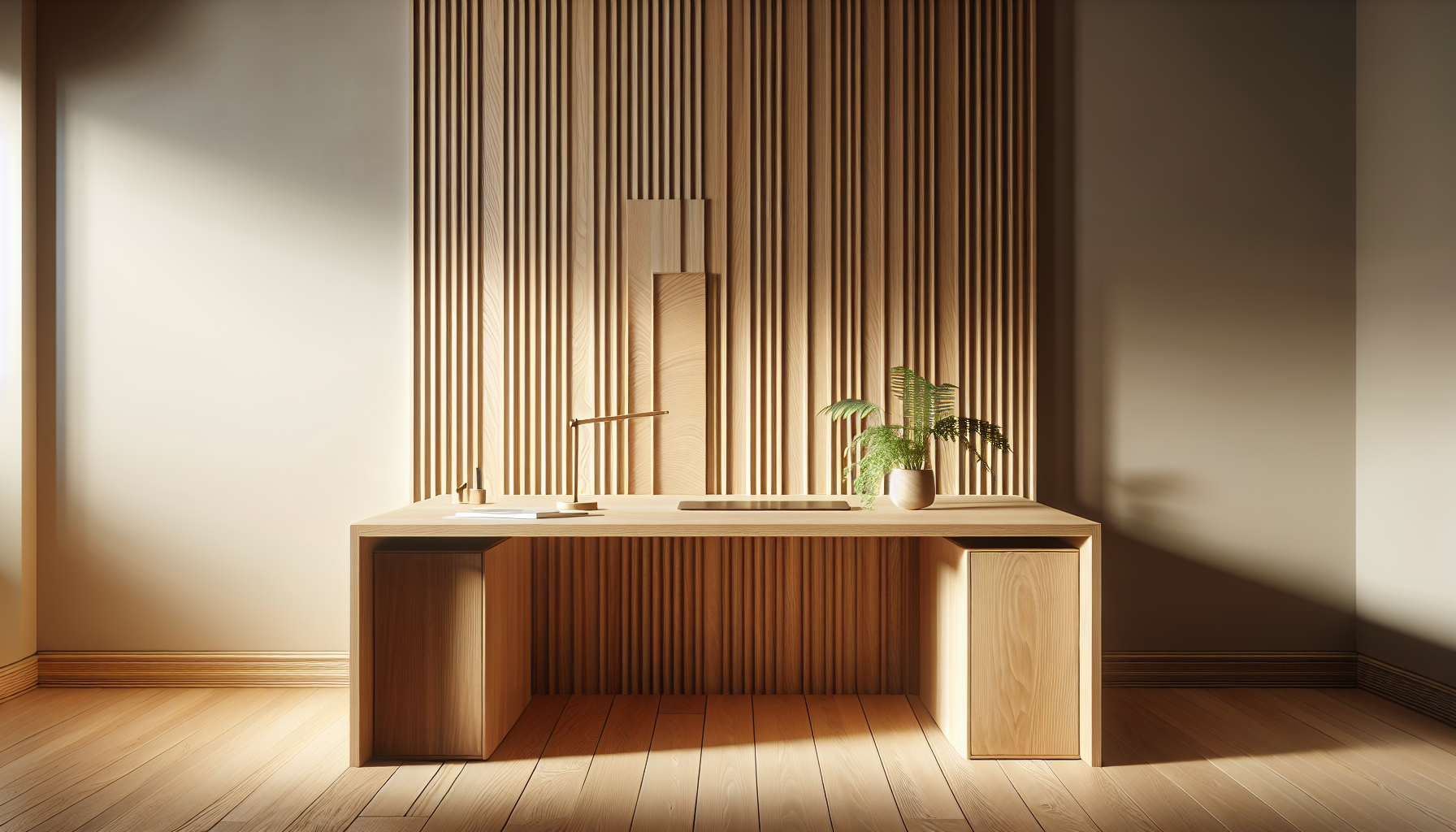Have you ever thought about how the environment you work in can profoundly influence your creativity?
Understanding Japandi Style
Japandi style merges two distinct aesthetics: Japanese minimalism and Scandinavian functionality. The result is a serene, uncluttered space filled with soothing colors, natural materials, and handcrafted elements. When you adapt the Japandi style for a creative studio, you create an environment that fosters productivity, inspiration, and a sense of calm.
Key Aspects of Japandi Style
It’s important to grasp some fundamental characteristics of Japandi style. Understanding these aspects will help you adapt this aesthetic to a creative studio effectively.
-
Minimalism: The essence of Japandi lies in minimalism. The idea is to declutter your space, allowing only the essentials that serve a purpose or spark joy.
-
Natural Materials: Emphasizing craftsmanship, Japandi incorporates wood, bamboo, linen, and stone. Using these materials will help bring a warm, tactile quality to your studio.
-
Neutral Color Palette: Soft, muted colors dominate the Japandi aesthetic. Shades like beige, soft gray, and pastels provide a tranquil setting that encourages focus.
-
Functional Design: Every element in a Japandi space is thoughtfully chosen for its function and beauty. This aspect encourages you to pick pieces that are not only visually appealing but also serve a purpose in your workflow.
-
Indoor Plants: Nature is a big part of Japandi. Incorporating plants into your studio not only enhances air quality but also introduces a sense of liveliness and balance.
Now that you have a clearer picture of what Japandi style entails, let’s look at how to transform your creative studio accordingly.
Decluttering Your Space
You won’t believe how much your creativity can be affected by a cluttered environment. The first step in adapting Japandi style is to declutter your studio.
The Power of Less
Adopting a minimalist approach means removing unnecessary items. Here’s how to do it:
-
Start Small: Focus on one area at a time—your desk or a shelf—before moving on to the entire studio.
-
Ask Yourself: Does each item serve a purpose? Does it inspire creativity? If the answer is no, it’s likely time to part ways.
-
Storage Solutions: Invest in stylish storage solutions that keep the essentials organized without overwhelming the space.
Choosing the Right Furniture
Furniture plays a crucial role in setting the tone of your studio. In Japandi style, pieces should be functional, simple, and beautiful.
Characteristics of Japandi Furniture
When selecting furniture, keep these pointers in mind:
-
Low-profile Designs: Look for pieces that are closer to the ground, as this creates an open and airy feel in the room.
-
Natural Wood Finishes: Opt for furniture made from oak, beech, or ash. These woods offer a beautiful texture that adds warmth without visual clutter.
-
Sleek Lines: Choose furniture with clean lines and simple shapes, avoiding overly ornate designs.
Here’s a quick comparison of furniture choices that align well with Japandi style:
| Furniture Type | Recommended Style | Example |
|---|---|---|
| Desk | Minimal, functional, wooden | Solid wood desk |
| Chairs | Simple, ergonomic, upholstered | Scandinavian lounge chair |
| Shelving Units | Open, airy design, wood-based | Floating wooden shelves |
| Lighting Fixtures | Soft, simple designs | Industrial pendant light |
Selecting a Color Palette
Your color palette sets the mood for the entire studio. In Japandi design, the focus is on muted, soothing tones.
Building a Neutral Foundation
When painting or selecting decor, consider:
-
Base Colors: Start with soft whites, creams, or beiges for the walls, which provide a calming backdrop.
-
Accent Colors: Incorporate soft pastel shades or earthy tones through furniture and decor pieces to add depth without overwhelming the senses.
-
Textures Matter: Use different materials, like fabric cushions or woven rugs, to introduce subtle variations in the neutral palette without clashing.
Lighting Your Creative Studio
Lighting is incredibly important in cultivating the right atmosphere for creativity. Japandi style encourages natural light but also values soft illumination.
Maximize Natural Light
Start by assessing your studio’s windows and natural light access. Here are some tips to enhance this element:
-
Maintain Clear Windows: Keep window treatments minimal or opt for sheer curtains that allow ample light.
-
Reflective Surfaces: Incorporate mirrors or glossy surfaces to bounce light around the room effectively.
Layering Light Sources
Use various light sources to create a warm ambiance. Here’s a simple approach:
-
Task Lighting: Add focused lights for your workspace, such as desk lamps with warm-toned bulbs.
-
Ambient Lighting: Soft overhead lighting can create a cozy atmosphere, balancing the studio’s overall feel.
-
Decorative Lamps: Choose unique lamps that embody Japandi design while also enhancing the functionality of your space.
Incorporating Natural Elements
Nature is a vital component of the Japandi aesthetic. Incorporating natural elements can help ground the space and make it more inviting.
Plants and Greenery
Introducing plants into your studio can make a significant difference. Here’s how to choose the right ones:
-
Low-maintenance Varieties: Opt for plants like succulents, snake plants, or pothos that require minimal upkeep but brighten up the atmosphere.
-
Use Natural Pots: Earthy pots made of clay or woven materials seamlessly integrate with the Japandi aesthetic.
Natural Textiles
Textiles made from sustainable materials contribute a touch of comfort while maintaining visual appeal.
-
Textiles for Comfort: Use organic cotton, linen, or wool for throws, cushion covers, and rugs. These textures add warmth and a cozy feel to your studio.
-
Neutral Patterns: Select patterns that are subtle and understated. Stripes or soft geometrics can echo the simplicity of Japandi style.
Personalizing Your Space
While Japandi style is unified in its themes, infusing your personality will make your studio truly your own.
Artistic Touches
Personal items can elevate your studio without overwhelming the space.
-
Artwork Displays: Select a few pieces of art that resonate with your creative spirit. Choose simple frames that blend well with the natural wood elements.
-
Handcrafted Items: Incorporate ceramics, handwoven baskets, or unique sculptures that reflect your artistic talents.
Creating Zones
In a creative studio, having distinct zones can help improve workflow and focus.
-
Workspace: Designate a section for your desk and tools, optimizing for functionality and organization.
-
Relaxation Area: Consider a cozy reading nook with a chair and a small side table for inspiration breaks.
-
Creative Corner: Set aside space for exhibits of your work, mood boards, or creative resources.
Making Use of Technology Mindfully
Modern technology often finds its place in creative spaces, but it’s essential to integrate it mindfully.
Selecting Essential Devices
While maintaining a minimalist approach, ensure you keep technology that supports your creative endeavors.
-
Choose Wisely: Invest in reliable devices that align with your work needs—like a high-quality monitor or a good printer—without cluttering the space.
-
Hide the Wires: Use cable organizers or focused storage to keep wires tidy and out of sight, preserving the clean, serene atmosphere of your studio.
Creating a Routine to Maintain Your Space
Once you’ve adapted the Japandi style in your creative studio, establishing a routine will help keep the space inviting and productive.
Daily Practices
Implementing small daily habits can make a world of difference:
-
Start Fresh Daily: Spend a few minutes every morning tidying up the workspace to maintain a clean environment.
-
Mindful Breaks: Incorporate short breaks within your creative process. Take time to step back and appreciate the elements in your studio that inspire you.
Weekly Check-ins
Dedicating time each week to reassess your studio can help you maintain the Japandi ethos:
-
Clean and Organize: Allocate time to declutter items that no longer serve your creative purpose.
-
Refresh Your Decor: Rotate plants or change small decor items to keep the space feeling dynamic and inspiring.
Conclusion
Transitioning your creative studio to a Japandi style can lead to a more productive, peaceful, and inspiring environment. With its focus on minimalism, natural materials, and functionality, you’ll find a balanced atmosphere that promotes creativity. By following these suggestions, you can create a space that reflects not only your artistic values but also provides a serene background for your work.
Adopting Japandi style is not just about aesthetics; it’s about creating a mindset conducive to creativity. Take your time, make meaningful changes, and enjoy the transformation of your creative space.

